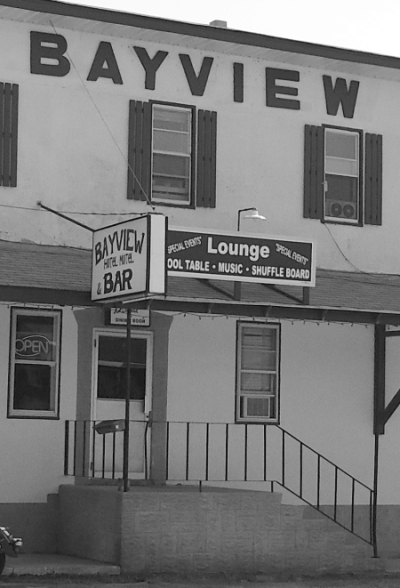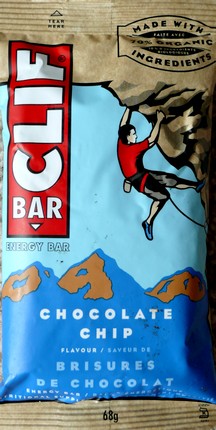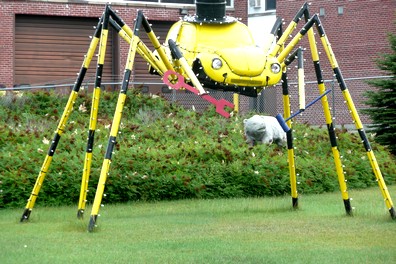
And for those of you wanting to inject a little more excitement into your flying career: try getting your hands on one of these.
I met the late Leland Snow, the owner of Air Tractor, back in the ’90s.

And for those of you wanting to inject a little more excitement into your flying career: try getting your hands on one of these.
I met the late Leland Snow, the owner of Air Tractor, back in the ’90s.

Update March 29, 2011: If these Saskasippie farmboys were working on constructing the Alaska Highway, road work would still be going on and the Japanese would be at the border. In 2011
work will require the highway to revert to two-lane traffic during construction. —Saskatchewan Government news release,December 9, 2010
In other words, a Saskatchewan farmboy wanting to get to Calgary for a rub-and-tug means having to say you’re sorry for the delay.
Jesus, what an embarrassment.
* * *
Back on June 16th, 2010 the Trans-Canada Highway at the western edge of Saskatchewan* was closed due to extensive rain damage during one of those prairie rainstorms not uncommon across the prairies.
It’s the 6th of August now. The four-lane divided highway is open for two-lane traffic only for a couple of miles. Some unknown construction company dilly-dallies away the summer pretending to construct. Methinks said construction company saw a way to endless cost-plus profits and is milking the Saskatchewan cow for all she’s worth.
How do I know? For the second time I rode by while traveling and had a look, and lo, it would appear that dimwits prevail.
The culverts haven’t even been laid yet, although my thought (not that my thoughts really matter to anyone in control) is that perhaps a bridge is warranted across an area that is prone to flooding.
A second thought: culverts are easier to replace than a bridge when the road washes out for a second time. It’s the farm mentality at work. They figger if she’s good to go by the time the snow flies, it’s good enough for those poor folk who are silly enough to be on the way to somewhere else. I think they figger too that it will slow down the locals in their attempt to desert Saskasippi in droves. Those shiny city lights on the horizon are a siren call, doncha know.
Did any of the farmers elected to the Saskatchewan government ever kick the shit off of their boots, pick the straw off of the ass of their pants, pull their heads out of their asses and try to figger out how long it really takes to repair a road? With culverts?
>>> crickets chirping <<<
I didn’t think so.
———–
*Saskatchewan to many is known as Saskasippi. Need I say more?
I like to ride long distances when I get out on the road. Stopping to eat in a restaurant is a real treat during those times, but it eats up time when I’d rather be out on the blacktop making distance. I like to get on the road early and put in at least a couple of hundred before breakfast.
So what do I do?
A&W.
You can get a pretty good eggs-over-easy and wheat toast at an A&W. It’s quick, it’s hot, and it’s hard to screw up eggs – although not impossible for some places. I don’t bother with the bacon or the potatoes. Who needs that deep-fried grease first thing in the morning laying like a lump in your stomach until noon?
Occasionally – but not often – I’ll get stuck and try an eat’n’puke, but for the most part I’ve learned my lesson and ignore them completely. My one exception: Tim Horton’s for breakfast, although, strictly speaking, Tim Horton’s is no eat’n’puke. It’s very good food. A late-afternoon stop for soup and a sandwich isn’t to be trifled with should I manage to find one en route.

My personal favorite snack bar is a CLIF bar. It comes in a foil pouch, and packs excellent taste into a small package. In texture, it’s much like a granola bar, although it’s soft, moist and very chewy. I’m not going to go into the relative merits of one bar over the other, since a simple search will pull up all of that information.
Added bonus: CLIF bars can be bought in bulk at any Costco. Each box will come with enough flavors to keep from getting bored with the taste.
When I want to spend time chewing, I pick up some dried beef and stuff it in a fairing pocket. Despite its salt content, I’ll snack on that for a few miles while giving my jaw a pretty good workout. Unfortunately, the salt content is a little high to make it a regular treat, so I don’t buy beef jerky all that often.
Most important of all is staying hydrated. Drinking plenty of fluids can’t be over-emphasized, and the best fluid is water, bar none.
This summer, I was riding wet for many of the miles I traveled. I own a good Gore-Tex rainsuit, so I stayed dry. Being the lazy SOB that I am, however, I let my feet get wet because I never put on my gaiters. Fortunately, it wasn’t cold.
On the rainy highway, traction is a major consideration at speed, and hydroplaning is never far away on two wheels if your speed is high. Hydroplaning can occur any time one rides through the puddles that collect in the lowest part of the roadway, primarily the two tire tracks running the length of each lane. It can be avoided by riding on the high spots and by keeping tire pressure on the high side. Running on bald tires isn’t good either.
In built-up areas, anything metal such as manhole covers and bridge gratings, painted lines, and places where oil and grease have not washed off become a lot more slippery when first wet.
Railroad tracks are a sleeper, and can bite hard when being crossed at anything other that parallel or almost-parallel, especially in the wet. If your tire slips into the groove running alongside the track, it will ruin your day.
Thunderstorms are scary when you’re in the middle of one out on the prairie. Being the highest point on a flat plain or at the top of a bald hill when the lightning comes crashing down is not a smart place to be. Avoid it, at all costs, or one day you’ll be sorry. Take a break at one of those fancy Canadian rest areas.
Last, but not least, don’t delay when putting on the rain suit. Riding just a little farther to see if it will clear is not always a good thing if you want to stay warm and dry. Ask me how I know.
To sum up, in the wet:
* Botts’ Dots are used on California multi-lane freeways. They come colored, round and square. Most are white; center markers are amber; wrong-way markers are red; fire hydrant markers are blue. They are being used on the highways of other states as well.
Slime is everywhere, most notably if one is an habitué of the gas bar in a well-traveled area. I pity the poor tourist who fills his tank and wanders into the store to pay in cash. If he’s lucky, he’s rounded up to the nearest dollar, which makes counting his change that much easier.
More likely, he’s at a gas’n’go and has used his credit card at the pump, but must wander into the store for water, pop, gum, cigarettes, or a treat for his sweet tooth.
If the day is long, like mine are, then attention isn’t at its highest.
High enough, mind you, to let the teller know that I gave her a twenty.
“Oh, sorry,” she replies, sounding too practiced and too much in haste. An honest error more often gets a fumbled reply.
When the cashier is trying to take you, the cash goes right into the till before she gives change back.
If the cashier is smart, the bill is left laying on the till while she hands you your change. That way, you can’t screw the cashier by telling her that you gave her a larger bill. It evens things out.
Still holding out my open hand, I get my ten dollars added to the change in my palm. When I press the point by looking the cashier in the eye, she looks away, then turns around and pretends to do something else.
Nice try, sez I.
No response, but then, I didn’t expect one.
I waited for about 20 seconds before I turned and left.
Out of the corner of my eye, I watched as she then turned around.
I waved the ten at her as I was going out the door.
I really enjoyed cheating the thief out of her ten-spot.
